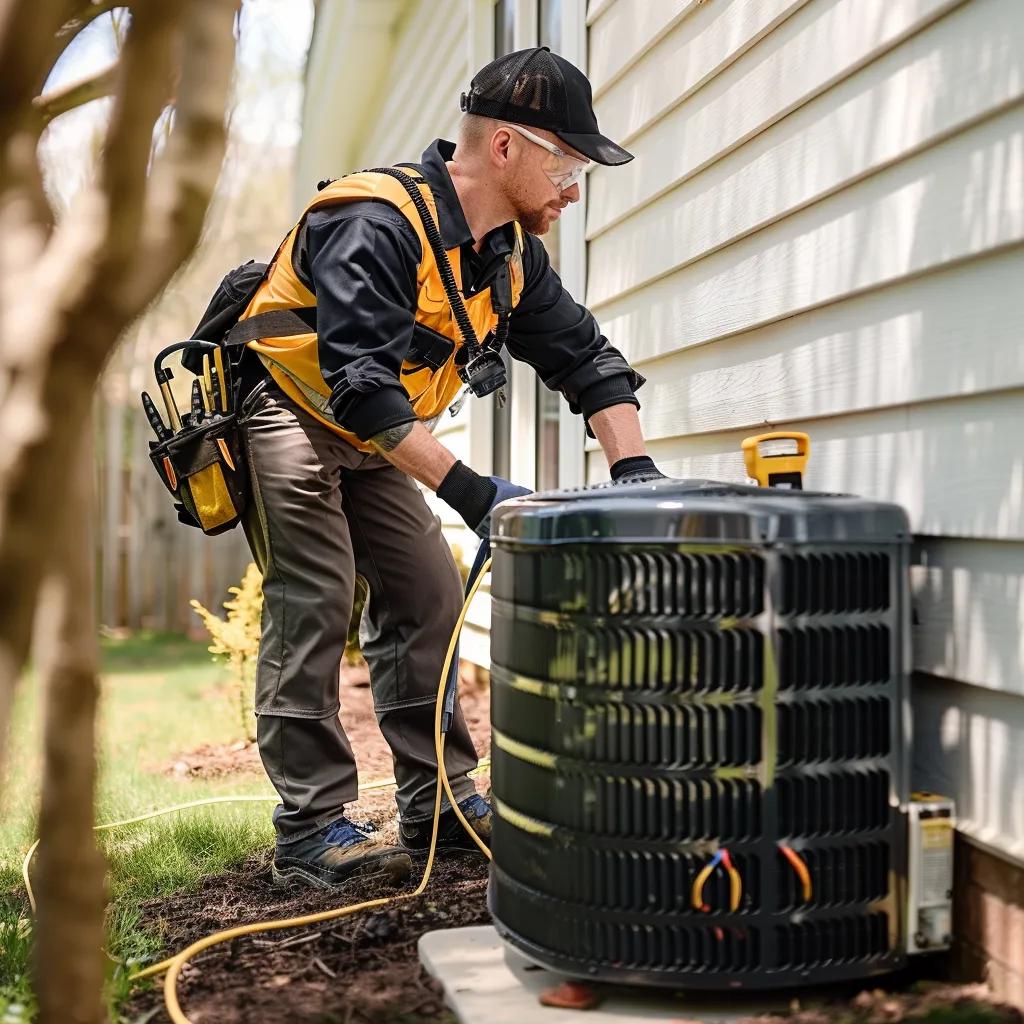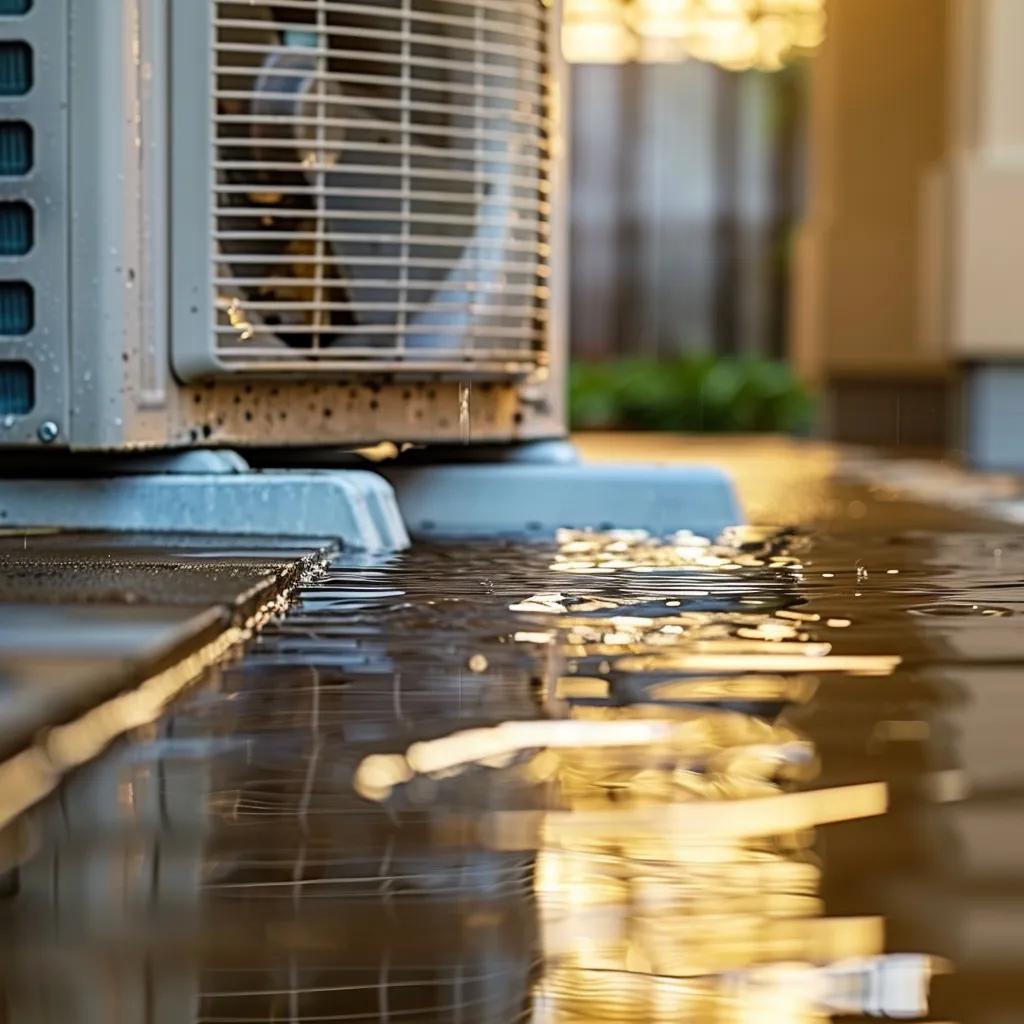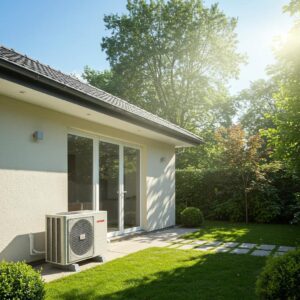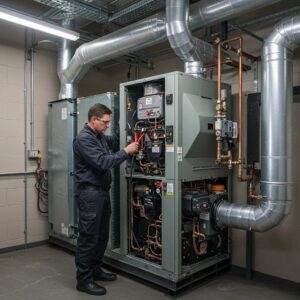
5 Signs You Need Local Heat and Air Repair Services Now: How to Identify HVAC Repair Warning Signs and When to Call a Professional
Your HVAC system is the single most important appliance for home comfort and safety, and early detection of problems saves money, prevents safety risks, and preserves indoor air quality. This article will teach you how to recognize five clear signs that you need local heat and air repair services now, explain the mechanical reasons behind each sign, outline homeowner-friendly diagnostic checks, and show when DIY stops and a certified HVAC technician must take over. You’ll learn to map symptoms like unusual noises, weak airflow, strange odors, water leaks, and rising energy bills to likely causes such as a failing blower motor, refrigerant leak, clogged drain, or short cycling. Each section gives immediate actions you can safely take, step-by-step troubleshooting, and concise decision guidance so you can choose emergency service or routine repair with confidence. Throughout, key terms like HVAC repair, refrigerant leak, short cycling HVAC, furnace repair, AC not cooling, and HVAC technician are used to help you act fast and talk precisely with a local professional when needed.
What Are the Most Common Unusual Noises Indicating HVAC Repair Is Needed?

Unusual HVAC noises are audible diagnostics: each distinct sound points to specific mechanical or electrical failures that affect performance and safety. Rattling, banging, screeching, clicking, hissing, and buzzing map to loose panels, failing bearings, belt or motor issues, relay problems, refrigerant leaks, or electrical faults respectively, and early identification shortens repair time and reduces parts damage. Listening closely while observing other symptoms—vibration, changes in airflow, or performance loss—helps prioritize whether a quick homeowner check is safe or a technician visit is required. Below you’ll find a concise noise list with likely causes and safe first steps to narrow the issue before escalating to professional repair.
This list highlights the most common unusual HVAC noises and their immediate implications:
- Rattling: Loose panels, debris, or unsecured duct straps causing vibration and noise.
- Banging: Sudden impacts indicating broken fan blades or severe motor issues that risk further damage.
- Screeching: Worn bearings or a failing blower motor belt causing friction and eventual seizure.
- Clicking: Electrical relays or control board issues that can precede failure to start.
- Hissing or Buzzing: Possible refrigerant leak or electrical arcing that requires rapid attention.
These noise descriptions help you match sound to cause quickly; use them to document symptoms (time of day, frequency, and conditions) so any technician can diagnose faster and more accurately.
Which Noises Signal Loose Parts or Motor Issues?
Rattling versus banging helps differentiate minor fastener problems from serious mechanical failure: rattling often means loose panels or debris, while banging typically signals a larger rotating part failure. Inspect only visually with power off—look for loose screws, detached duct straps, or visible debris near the fan and housing; avoid touching moving parts or energized components. If tightening screws or removing debris eliminates the sound, monitor the system for recurrence; persistent or worsening banging or screeching indicates bearing failure or imbalance that requires professional motor repair or replacement. Document the noise pattern and any visual clues so a technician can prioritize bearing replacement, fan blade repair, or blower motor service during their visit.
How Do Refrigerant Leaks Cause Hissing or Buzzing Sounds?
A hissing or high-pitched buzzing near the outdoor unit or evaporator coil commonly signals a refrigerant leak under pressure, and it often pairs with decreased cooling capacity and ice on evaporator coils. Refrigerant issues reduce system efficiency and can damage the compressor if left unaddressed, and handling refrigerant requires EPA-compliant technicians because of environmental and safety regulations. Homeowner checks are limited to observing warm discharge air, higher indoor humidity, and visible oil stains around fittings; do not attempt to recharge refrigerant yourself. When hissing is present with performance decline or frozen coils, shut the system off to prevent compressor damage and arrange professional HVAC repair.
How Can Weak Airflow or Inconsistent Temperatures Reveal HVAC Problems?
Weak airflow and inconsistent temperatures are direct indicators of restricted system performance and may stem from simple maintenance items or serious mechanical failures that reduce comfort and increase wear. Common causes include a dirty air filter, closed or blocked vents, duct leaks, a failing blower motor, or compressor/refrigerant problems; each reduces the system’s ability to move conditioned air and control temperature. A short homeowner checklist—inspect and replace the air filter, check vents and registers for obstructions, verify thermostat settings and breakers—often restores comfort quickly if the issue is superficial. If basic checks fail, professional diagnostics like duct leakage testing, blower current draw, and compressor health checks are necessary to identify repairs that prevent long-term damage.
Quick homeowner troubleshooting steps to check airflow and temperature consistency:
- Check and replace the air filter if dirty or clogged.
- Ensure vents and registers are open and unobstructed.
- Confirm the thermostat mode and temperature setpoint, and check circuit breakers.
- Inspect the outdoor unit for debris and the indoor blower access panel for loose connections.
If airflow remains weak after these checks, call a technician for duct testing or blower motor evaluation.
Introduce the symptom→cause→fix comparison below to help you match low airflow to likely fixes and speed decision-making.
| Symptom | Possible Cause | Likely Fix |
|---|---|---|
| Low airflow at registers | Dirty/blocked air filter | Replace filter; schedule routine filter changes |
| Weak flow in one room | Closed/obstructed vent or duct obstruction | Open vents; inspect ductwork or remove blockage |
| Overall low airflow | Blower motor failing or capacitor weak | Technician blower motor test and possible motor/capacitor replacement |
| Uneven temperatures | Duct leaks or poor balance | Duct sealing, rebalancing, or insulation improvements |
| Warm discharge air with good fan | Refrigerant or compressor failure | Professional refrigerant/ compressor diagnostics and repair |
Why Is My AC Blowing Warm Air and What Does It Mean?
An AC that blows warm air often indicates a chain of failures starting with simple settings and filters, and escalating to refrigerant shortage, compressor failure, or electrical faults. Start with the basics: ensure the thermostat is set to cooling and the breaker and disconnect are on, then check and replace the air filter and clear the outdoor unit of debris to restore airflow. If the blower runs but the discharge is warm and the outdoor unit is quiet or freezing, suspect low refrigerant or compressor issues that require a certified technician and refrigerant-handling credentials. Prolonged operation under these conditions risks compressor burnout, so schedule professional service promptly when basic checks do not restore cool air.
What Causes a Furnace to Blow Cold Air or Uneven Heating?
A furnace blowing cold air or delivering uneven heat can be due to thermostat calibration, blocked burners, pilot/ignition failure, a clogged filter restricting airflow, or ductwork imbalance that starves rooms of conditioned air. Begin with simple homeowner checks: replace the furnace filter, confirm thermostat mode and temperature, and ensure vents are open and unobstructed; these actions often resolve calibration or airflow problems. If cold air persists, a failing ignition system, cracked heat exchanger, or control board fault may be responsible and require immediate professional inspection because of combustion safety concerns. Arrange qualified furnace repair when ignition failures or unusual odors accompany cold output, and avoid continued use until a technician confirms safe operation.
What Do Strange Odors from Your HVAC System Indicate About Its Condition?
Odors emitted by an HVAC system are powerful diagnostic clues: musty smells often point to mold or moisture issues, burning odors indicate electrical or mechanical overheating, and rotten egg aromas signal a gas leak that demands immediate evacuation. Mapping smell to source can prioritize safety actions—run the fan and change the filter for musty smells, power down the system and call a technician for a burning odor, and evacuate and contact emergency services for any rotten egg or gas scent. Indoor air quality concerns tied to odors are not just unpleasant; mold and combustion byproducts affect health and structural integrity, so persistent smells require professional remediation and targeted HVAC repairs. Below is a practical odor guide and next steps to protect occupants and home systems.
Common odor types and what they typically mean:
- Musty: Mold or microbial growth in ducts, evaporator coil, or drip pan; indicates moisture and IAQ risk.
- Burning: Overheating electrical components or motor bearings; stop the system to avoid fire risk.
- Rotten egg: Natural gas leak in a gas furnace or appliance; immediate evacuation and emergency response required.
Act on odors promptly: document when the smell occurs and what system mode correlates to the odor, because this information speeds diagnosis and repair by an HVAC technician.
What Does a Musty Smell Suggest About Mold or Air Quality Issues?
A persistent musty odor usually signals microbial growth in damp components such as the evaporator coil, condensate pan, or ductwork, and it often worsens in warm, humid seasons. Short-term homeowner steps include running the system fan to dry coils, replacing the air filter, and visually inspecting the condensate pan and drain line for standing water or clogs; these actions can reduce odor temporarily. If the smell returns or occupants experience respiratory symptoms, schedule professional coil cleaning, drain-line clearing, and targeted duct cleaning or mold remediation to restore safe indoor air quality. Long-term prevention includes ensuring proper condensate drain maintenance and addressing humidity control through ventilation or dehumidification strategies.
How Should You Respond to Burning or Rotten Egg Smells?
Burning smells require immediate shutdown of the HVAC system and professional inspection because they often indicate electrical overheating, melting insulation, or motor bearing failure—conditions that can cause fires. For any rotten egg smell, treat it as a potential gas leak: evacuate the home, avoid using electrical switches or phones indoors, and contact emergency responders and your gas utility from a safe location. Do not restart the system after a burning smell until a qualified technician inspects wiring, controls, and motors; similarly, do not re-enter after a gas smell until the area is declared safe by authorities. Document the odor’s timing and source location to assist technicians in tracing the problem during repair.
How Do Water Leaks or Excessive Humidity Signal HVAC System Failures?

Water around HVAC equipment or high indoor humidity signals failures that can lead to mold, structural damage, and reduced cooling performance, so these signs warrant swift investigation. Common failure points include clogged condensate drain lines, cracked condensate pans, frozen evaporator coils (often from low refrigerant or poor airflow), and leaking fittings; each creates different risks such as water damage or microbial growth. Homeowner mitigation includes turning off the system if water is pooling, mopping up to prevent immediate damage, and visually checking the drain line and pan for obvious blockages; persistent or recurring leaks require professional intervention. The table below helps you match components to failure modes and immediate risks to guide urgency and next steps.
| Component | Failure Mode | Immediate Risk |
|---|---|---|
| Condensate drain line | Clog from algae/debris | Water backup, indoor flooding, mold growth |
| Condensate pan | Crack or rust-through | Leaks into attic or living spaces, structural damage |
| Evaporator coil | Freeze from low refrigerant or airflow | Sudden thaw leads to heavy water flow and damage |
| Refrigerant line fittings | Leak | Loss of cooling, potential environmental release |
| Outdoor unit base | Poor drainage or tilt | Pooled water causing corrosion and electrical hazards |
What Causes Puddles or Ice Formation Around HVAC Units?
Puddles near the indoor unit or ice on the evaporator coil can result from blocked condensate drains, cracked pans, or a frozen coil caused by low refrigerant or severely restricted airflow. Safely shut off the system to stop melting ice from flooding living spaces, and remove pooled water carefully while avoiding electrical components; photograph the area for technicians to aid diagnosis. Short-term fixes include clearing visible clogs from accessible drain lines and replacing visibly damaged pans, but recurring icing commonly requires refrigerant and airflow diagnostics performed by a certified HVAC technician. Professional repair prevents repeat failures and addresses underlying issues such as refrigerant charge, blower performance, or drain-line replacement.
How Can High Indoor Humidity Affect Your Home and HVAC System?
Sustained high indoor humidity reduces comfort, increases perceived temperature, and creates an environment conducive to mold growth and dust mite proliferation, which affects health and allergies. High humidity also forces the HVAC system to run longer to remove moisture, increasing wear, shortening service life, and raising energy bills; dehumidification or improved ventilation can restore balance. Homeowner steps include running exhaust fans, using portable dehumidifiers, and ensuring the HVAC system is not oversized or undersized for the home; persistent humidity issues often need professional assessment for whole-home dehumidification, duct sealing, or coil cleaning. Addressing humidity proactively improves indoor air quality and reduces the chance of moisture-related structural damage over time.
Why Are Unexpectedly High Energy Bills or Frequent Cycling Signs of HVAC Trouble?
A spike in energy bills or frequent short cycling signals increasing system inefficiency and stress that directly raises operating costs and shortens equipment life. Contributors include dirty filters, restricted airflow, refrigerant leaks, failing capacitors or motors, thermostat miscalibration, or an oversized/undersized unit that cycles inefficiently. Simple homeowner actions—replacing filters, sealing visible duct leaks, and checking thermostat schedules—can produce measurable savings, but persistent inefficiency requires professional diagnostics to quantify losses and recommend repairs or upgrades. The following table links common inefficient components to their typical impact on bills and performance so you can judge urgency and potential ROI from timely repairs.
| Component | Inefficiency Attribute | Impact on Bills / Performance |
|---|---|---|
| Dirty air filter | Increased fan run time | 5–15% higher energy use; reduced airflow |
| Refrigerant leak | Lower cooling capacity | 10–30% reduced efficiency; longer run cycles |
| Short cycling | Increased start/stop cycles | Higher energy use, increased wear, shortened lifespan |
| Blower motor inefficiency | Reduced airflow delivery | Lower comfort, higher runtime, higher energy draw |
| Duct leakage | Lost conditioned air | Up to 20% energy loss in poorly sealed systems |
It’s well-documented that HVAC systems are significant energy consumers, and operational faults are a primary driver of their inefficiency.
HVAC System Faults: Causes of Inefficiency and Energy Savings
Building HVAC systems account for more than 30% of annual energy consumption in United States. However, it has become apparent that only in a small percentage of buildings do HVAC systems work efficiently or in accordance with design intent. Studies have shown that operational faults are one of the main reasons for the inefficient performance of these systems. It is estimated that an energy saving of 5 to 15 percent is achievable simply by fixing faults and optimizing building control systems.
Fault detection and diagnosis in building HVAC systems, 2010
How Does HVAC Inefficiency Lead to Rising Utility Costs?
Inefficiency increases runtime and reduces output per unit energy: for example, a dirty filter or a low refrigerant charge forces the compressor and blower to work harder and longer to achieve the same temperature. This translates to higher kilowatt-hour use and greater compressor wear, and studies and industry guidance indicate that routine maintenance can restore a significant portion of lost efficiency. Immediate homeowner steps include replacing filters, clearing debris from the outdoor unit, and verifying thermostat programming to prevent wasteful operation; if bills remain high, schedule a professional energy audit or HVAC tune-up. Repairing the core issue—refrigerant leaks, failing motors, or duct sealing—provides the largest and most reliable cost reductions.
What Is Short Cycling and How Does It Affect System Performance?
Short cycling occurs when the system turns on and off frequently before completing a full thermal cycle, usually due to incorrect system sizing, thermostat placement, airflow problems, or safety limit trips; it causes excessive wear on compressors and increases energy consumption. Signs include frequent starts per hour, rapid temperature swings, and unusual noises at startup, and technicians diagnose it via runtime logs, thermostat checks, and airflow measurements. Remedies range from adjusting thermostat location or settings to replacing mis-sized equipment, repairing airflow restrictions, or addressing control and limit switch failures. Resolving short cycling improves comfort, reduces utility bills, and extends equipment life, making it a priority repair.
When Should You Call a Local HVAC Technician for Emergency or Routine Repair?
Deciding between DIY steps and professional service is a safety and cost trade-off: simple maintenance is homeowner-safe, but combustion, refrigerant, electrical, or water intrusion issues require certified HVAC repair. Before calling, perform a prioritized checklist—replace the filter, check breakers and thermostat settings, clear outdoor debris, and document symptoms with photos and notes—so the technician arrives informed and can diagnose faster. Emergency signs such as a gas smell, burning electrical odors, active flooding, or complete loss of heat in extreme cold demand immediate shutdown and professional emergency response; non-urgent but unresolved performance issues deserve scheduled diagnostics to prevent escalation. Below is a compact decision flow and homeowner checklist to guide action and help you communicate clearly with local heat and air repair services.
A safe, prioritized DIY checklist to run before calling a professional:
- Filter and vents: Replace dirty filters and ensure registers are open.
- Power and thermostat: Confirm breakers, disconnects, and thermostat settings.
- Outdoor unit: Clear debris and check for obvious damage to the condenser.
- Document: Photograph leaks, ice, error codes, unusual noises, or odors.
Complete these checks and note which items changed; if problems persist or warning signs (smoke, gas smell, persistent leaks, frozen coils) appear, arrange professional service rather than attempting further repairs yourself.
What DIY Checks Can Homeowners Perform Before Calling a Professional?
Homeowners can safely handle filter changes, thermostat verification, breaker checks, and outdoor-coil clearance to address many routine issues and to gather useful documentation for technicians. Always turn off power at the breaker before opening equipment panels, avoid touching refrigerant lines or electrical components, and do not attempt to access sealed system internals or refrigerant circuits. Record symptoms—temperature readings, photos of leaks, times when noises occur—and keep a short log to speed professional diagnostics and reduce on-site time. For any sign involving gas, electrical burning, persistent water intrusion, or refrigerant handling, stop and call a certified HVAC technician immediately.
Which Signs Require Immediate Professional Heat and Air Repair Services?
Immediate professional intervention is mandatory for red-flag issues that threaten safety or risk major equipment failure: confirmed gas smells (rotten egg), electrical burning odors or smoke, active flooding from HVAC components, severe refrigerant leaks with rapid performance loss, and total system failure in extreme temperatures. If occupants experience symptoms of carbon monoxide exposure, fainting, or severe respiratory distress in combination with HVAC faults, evacuate and contact emergency responders before calling repair services. Before the technician arrives, shut off affected equipment if safe to do so, document conditions (photos and descriptions), and avoid re-energizing the system; this preserves safety and aids diagnosis. Local technicians provide diagnostics, emergency response, and repair services, including system isolation, leak detection, control board and motor repair, and safe refrigerant handling to restore safe and efficient operation.
The complexity and critical nature of HVAC systems make automated fault detection and diagnostics a vital area of research for ensuring reliability and efficiency.
Automated Fault Detection and Diagnostics for HVAC Systems
In this comprehensive research paper, we delve into the transformative realm of Automated Fault Detection and Diagnostics (AFDD) within Heating, Ventilation, and Air Conditioning (HVAC) systems. As the intricacies of HVAC systems continue to evolve, AFDD emerges as a pivotal and proactive solution for the identification and diagnosis of faults, thereby bolstering system reliability, optimizing energy efficiency, and elevating overall performance.
Automated fault detection and diagnostics in HVAC systems, 2023
Frequently Asked Questions
1. What should I do if my HVAC system is short cycling?
Short cycling occurs when your HVAC system frequently turns on and off before completing a full cycle, which can lead to increased wear and higher energy bills. To address this, first check the thermostat placement and settings, as incorrect positioning can cause false readings. Ensure that air filters are clean and that there are no airflow restrictions. If the problem persists, it’s advisable to contact a professional technician who can diagnose underlying issues such as improper system sizing or control failures.
2. How can I improve indoor air quality with my HVAC system?
Improving indoor air quality (IAQ) can be achieved through regular maintenance and upgrades to your HVAC system. Start by replacing air filters every 1-3 months to reduce dust and allergens. Consider installing a whole-house air purifier or dehumidifier to control humidity levels and eliminate pollutants. Additionally, ensure proper ventilation by using exhaust fans and opening windows when weather permits. Regular duct cleaning can also help remove accumulated dust and mold, further enhancing IAQ.
3. What are the benefits of regular HVAC maintenance?
Regular HVAC maintenance is crucial for ensuring optimal performance and longevity of your system. Benefits include improved energy efficiency, which can lead to lower utility bills, and enhanced indoor comfort through consistent temperature control. Routine checks can identify potential issues before they escalate into costly repairs, ultimately extending the lifespan of your equipment. Additionally, regular maintenance helps maintain indoor air quality by ensuring that filters and ducts are clean and functioning properly.
4. How do I know if my HVAC technician is qualified?
To ensure your HVAC technician is qualified, check for proper licensing and certifications, which vary by state but typically include EPA certification for refrigerant handling. Reading customer reviews and asking for recommendations can also help you find a reputable technician. A qualified technician should provide clear explanations of the work needed and offer written estimates.
5. What are the signs of a failing blower motor?
Signs of a failing blower motor include unusual noises such as grinding or squealing, reduced airflow from vents, and frequent system cycling. If the blower motor is overheating, it may cause the system to shut down to prevent damage. Additionally, if you notice an increase in energy bills without a change in usage, it could indicate that the blower motor is working harder than normal. If you suspect a problem, it’s best to contact a professional for diagnosis and repair.
6. Can I perform my own HVAC repairs?
While some minor maintenance tasks, like changing air filters or cleaning vents, can be performed by homeowners, most HVAC repairs should be left to professionals. Handling refrigerants, electrical components, or gas lines poses safety risks and may violate local regulations. Attempting complex repairs without proper training can lead to further damage and increased repair costs. If you encounter issues beyond basic maintenance, it’s advisable to contact a certified HVAC technician for safe and effective repairs.
7. What should I do if I smell gas near my HVAC system?
If you detect a gas smell near your HVAC system, it’s crucial to act immediately. Evacuate the area and avoid using any electrical devices or open flames, as these can ignite the gas. Once you are at a safe distance, contact your gas utility company and emergency services. Do not attempt to locate the leak yourself. After the area has been deemed safe, a qualified technician can inspect your system for leaks and perform necessary repairs to ensure safety.



